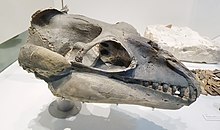| Janjucetus Temporal range:
| |
|---|---|

| |
| Skull of Janjucetus hunderi at the Melbourne Museum | |
| Scientific classification | |
| Domain: | Eukaryota |
| Kingdom: | Animalia |
| Phylum: | Chordata |
| Class: | Mammalia |
| Order: | Artiodactyla |
| Infraorder: | Cetacea |
| Family: | †Mammalodontidae |
| Genus: | †Janjucetus Fitzgerald 2006 |
| Species: | †J. hunderi
|
| Binomial name | |
| †Janjucetus hunderi | |
Janjucetus is an extinct genus of cetacean, and a basal baleen whale (Mysticeti), from the Late Oligocene around 25 million years ago (mya) off south-east Australia, containing one species J. hunderi. Unlike modern mysticetes, it possessed large teeth for gripping and shredding prey, and lacked baleen, and so was likely to have been a predator that captured large single prey animals rather than filter feeding. However, its teeth may have interlocked, much like those of the modern-day filter-feeding crabeater seal (Lobodon carcinophaga), which would have allowed some filter-feeding behaviour. Its hunting behaviour was probably similar to the modern-day leopard seal (Hydrurga leptonyx), probably eating large fish. Like baleen whales, Janjucetus could not echolocate; however, it did have unusually large eyes, and so probably had an acute sense of vision. The only specimen was found on the Jan Juc beach, where the remains of the extinct whales Mammalodon, Prosqualodon and Waipatia have also been discovered.